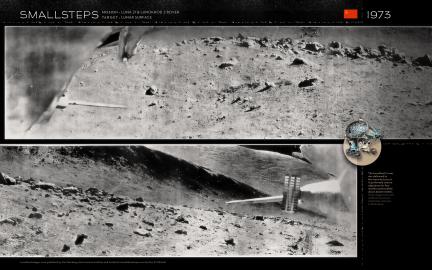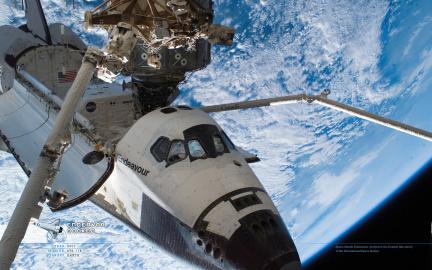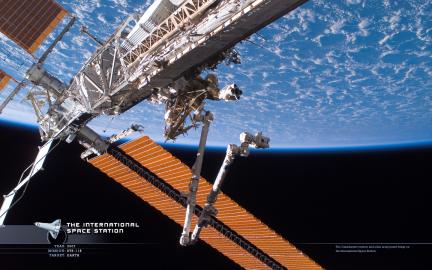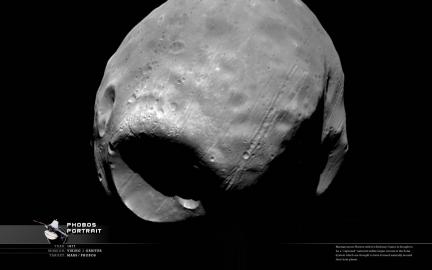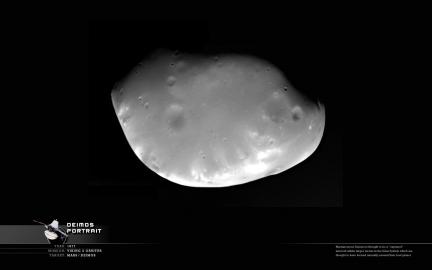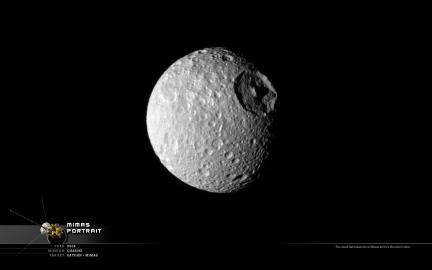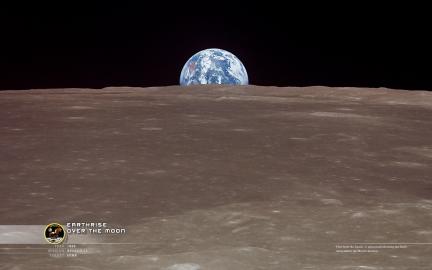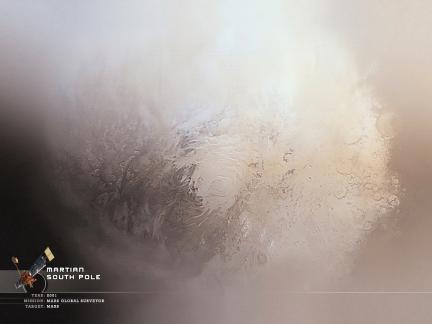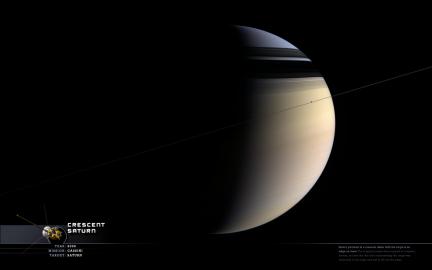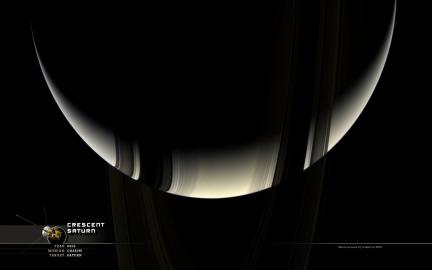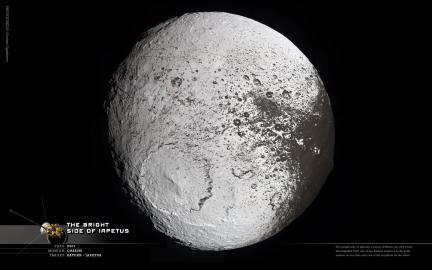 It had to happen… regularly featured on this site Gordan Ugarkovic stitches together an awesome hi-res full globe image of Iapetus only a few days after the closest approach (see previous post for even larger sized wallpaper for bigger monitors). I usually only label an image a “portrait” once for each body, but seeing as Iapetus has two different sides… I think it deserves two. Here is the darker side imaged earlier in 2005.
It had to happen… regularly featured on this site Gordan Ugarkovic stitches together an awesome hi-res full globe image of Iapetus only a few days after the closest approach (see previous post for even larger sized wallpaper for bigger monitors). I usually only label an image a “portrait” once for each body, but seeing as Iapetus has two different sides… I think it deserves two. Here is the darker side imaged earlier in 2005.
2560 x 1600 Set 01
Smallsteps Wallpaper: Luna 9
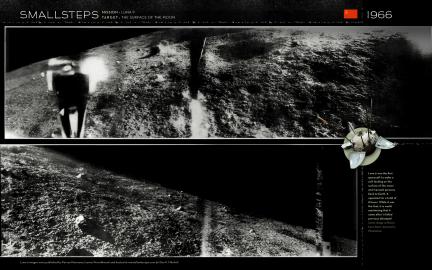 The very first time we humans ever had a look at the surface of another world was in 1966 with the Luna 9 spacecraft. The event is nearly wiped from our collective memory after the successes of Apollo, but at the time this was another feather in the cap of the Soviet Space Program. Now they were able to claim the first successful touchdown as well as first man in space, first spacewalk, first object in space… you name it.
The very first time we humans ever had a look at the surface of another world was in 1966 with the Luna 9 spacecraft. The event is nearly wiped from our collective memory after the successes of Apollo, but at the time this was another feather in the cap of the Soviet Space Program. Now they were able to claim the first successful touchdown as well as first man in space, first spacewalk, first object in space… you name it.
Smallsteps Wallpaper: Luna 21 & Lunokhod 2
Smallsteps Wallpaper: Luna 17 & Lunokhod 1
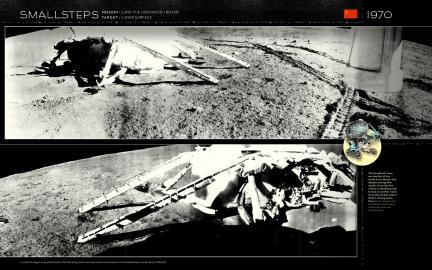 More than a year after Americans set foot on the moon in 1969, the Soviets landed the worlds first remote “rover” type vehicle ever to explore the surface of another world. One almost has to wonder how the politics of this mission even played out to bother even letting it continue. It would hardly seem worthwhile sending a robot to do the work actual humans would be conducting 5 more additional times beyond the historic Apollo 11 landing from the year previous.
More than a year after Americans set foot on the moon in 1969, the Soviets landed the worlds first remote “rover” type vehicle ever to explore the surface of another world. One almost has to wonder how the politics of this mission even played out to bother even letting it continue. It would hardly seem worthwhile sending a robot to do the work actual humans would be conducting 5 more additional times beyond the historic Apollo 11 landing from the year previous.
The rover was named “Lunokhod” and translated means, “Moon Walker”, it carried out a mission for 11 days and traveled 10.5 km. Despite the fact that nobody knows exactly where the rover rests today, the rover and lander were sold at auction in 1993 for $68,500. The auction catalog read that it was, “resting on the surface of the moon”.
Smallsteps Wallpaper: Luna 3
The Soviet spacecraft Luna 3 was the third such craft to be successfully sent to the moon in history. The images were not very great, as can be seen… but it was the first glimpse mankind ever had of the side of the moon that is permanently facing away from us. With the first look at the “dark side of the moon” many people were quite excited and the images were published the world over. It took a total of 29 pictures and was able to image at least 70% of that unseen side of the moon.
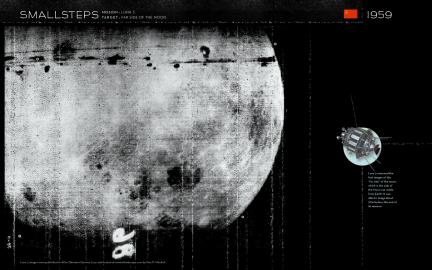
The image is largely intact but for the purposes of presentation I faked the “8” in the number on the bottom and actually added some noise lines.
Smallsteps Wallpaper: V2 Rocket
While looking at all the strange images from old Soviet moon missions on Don Mitchell’s site, I thought it would be interesting to design a set of wallpapers from these early images. I call the series “Smallsteps” as in Neil Armstrong’s famous, “One small step…” quote from Apollo 11. Obviously, there would have been no “giant leap” without a large number of these other “small steps” preceding the Apollo Program (although some of the images I have planned actually come after or during the Apollo program).
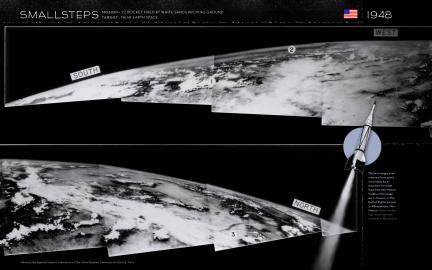
To me, the fact that the human race was even doing space exploration back then seems almost out of time — and then you look at the spacecraft that were sending back these images and it is amazing that anything really ever worked. Tin cans with cameras sending back images that were often just as bizzare and rough as the vessels that carried them. It is even more incredible when you consider that people eventually started strapping themselves to these rockets and floated around the vacuum of space in boxes wrapped with foil.
Seems appropriate enough to start the whole set off with the V2 images of Earth sent back in the shockingly early year of 1948. According the the Air and Space Museum these are the first images of the Earth taken from space in history. The image itself I suspect was just scanned from some print and the number tags and directionals are original (although there were about 17 of them and I removed a majority of them in Photoshop).
Wallpapers: Earth from the Space Shuttle
Something impressive seems to be happening on STS-118 (the Space Shuttle mission currently in orbit)… Photography.
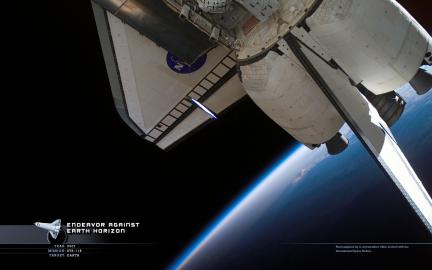
Surely there are many excellent images to be had from previous Shuttle missions, but the images coming from STS-118 are really something to see. Perhaps one of the astronauts doing the EVAs (extra vehicular activities) has a degree in photography? At any rate, this site’s recent effort to give Earth it’s fair presence on this site has to take advantage of some of these fantastic images coming from NASA.
If you would like to see more check out the current mission’s multimedia gallery here or digg the story here.
Wallpapers: Some of the Minor Moons
Wallpaper: Earth Portrait
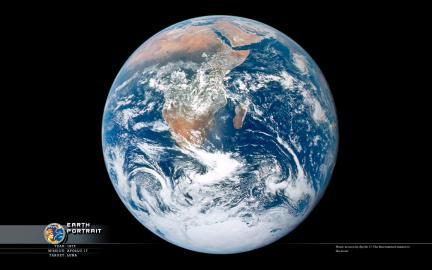 You have probably seen this image of the Earth before. This was the way the Earth appeared to the final astronauts to land on the moon in 1972. It has since become the quintessential Earth portrait, used more often than any other global image of the Earth. This is probably due to its beauty but also worth mentioning the relative rarity with which we get to see a full globe image taken of the Earth in one snapshot. Only missions and probes that leave the vicinity of the Earth are able to do this and some other popular Earth portraits have been taken by Galileo, Messenger… there is the famous Earth/Moon portrait taken by Voyager 1 and of course several from various Apollo missions.
You have probably seen this image of the Earth before. This was the way the Earth appeared to the final astronauts to land on the moon in 1972. It has since become the quintessential Earth portrait, used more often than any other global image of the Earth. This is probably due to its beauty but also worth mentioning the relative rarity with which we get to see a full globe image taken of the Earth in one snapshot. Only missions and probes that leave the vicinity of the Earth are able to do this and some other popular Earth portraits have been taken by Galileo, Messenger… there is the famous Earth/Moon portrait taken by Voyager 1 and of course several from various Apollo missions.
Wallpaper: Earthrise
Wallpaper: Martian North Pole
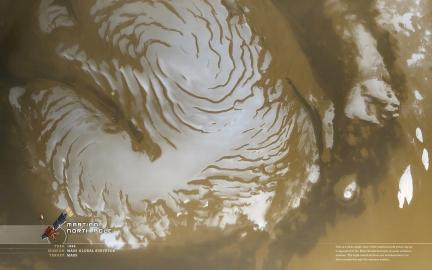 Since the Mars Phoenix Lander has now been successfully launched, and is on its way to potentially making the first ever successful landing in the Martian polar region… Here is a great image of the region taken from the Mars Recon Orbiter’s archives.
Since the Mars Phoenix Lander has now been successfully launched, and is on its way to potentially making the first ever successful landing in the Martian polar region… Here is a great image of the region taken from the Mars Recon Orbiter’s archives.
On a side note, there was one previous mission called the Mars Polar Lander which was to touch down in the region in 1999. Communication was lost with the lander just prior to the designated arrival date and the whereabouts of the probe have been a mystery ever since. Recently the Opportunity and Spirit rovers, the old Viking Landers and even the original Pathfinder components had been clearly imaged from orbit by the Mars Global Surveyor and that raised hopes we might finally make a visual connection with the remains of the doomed lander. Initially some hopeful findings had been made, but they later panned out and as of this date MPL still remains lost.
Wallpapers: 1024x768 Set 05
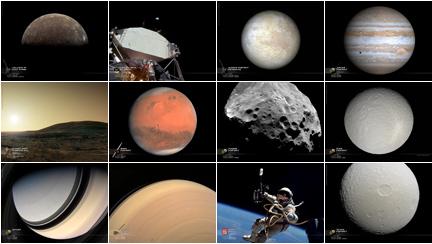 Managed to make the more common wallpaper size 1024x768 for the 14 most recent wallpaper posts (started with set 05 images, 1-4 to come). Download zip file here. Some were not produced as they just didn’t translate so easily into the format. However, the opposite is true in some cases such as for this image of the Martian south pole. Its resolution was hopelessly low for the larger landscape format, so now with the smaller size it was possible (just barely) to get it posted as a wallpaper.
Managed to make the more common wallpaper size 1024x768 for the 14 most recent wallpaper posts (started with set 05 images, 1-4 to come). Download zip file here. Some were not produced as they just didn’t translate so easily into the format. However, the opposite is true in some cases such as for this image of the Martian south pole. Its resolution was hopelessly low for the larger landscape format, so now with the smaller size it was possible (just barely) to get it posted as a wallpaper.
Included in the set for download are the images pictured at the top and for the sake of google search, here they are listed out:
- 1024x768 Wallpaper of CALLISTO at half view, moon of JUPITER
- 1024x768 Wallpaper of EARTH from APOLLO landing site
- 1024x768 Wallpaper portrait of EUROPA, moon of JUPITER
- 1024x768 Wallpaper portrait of JUPITER
- 1024x768 Wallpaper of MARS region of DEUTERONILUS (not shown)
- 1024x768 Wallpaper of MARS surface at HUSBAND HILL
- 1024x768 Wallpaper portrait of MARS
- 1024x768 Wallpaper portrait of PHOEBE, moon of SATURN
- 1024x768 Wallpaper portrait of RHEA, moon of SATURN
- 1024x768 Wallpaper of SATURN, crescent view (not shown)
- 1024x768 Wallpaper of SATURN from above the NORTHERN POLE
- 1024x768 Wallpaper of SATURN globe
- 1024x768 Wallpaper of SPACE WALK
- 1024x768 Wallpaper portrait of TETHYS, moon of SATURN
Wallpapers: Crescent Saturn Images
Wallpaper: Deuteronilus Mensae on Mars
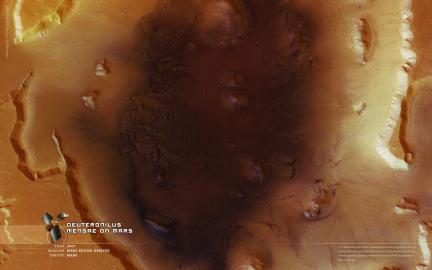 It is believed that these valleys may have originated from flash flood waters which came from melting ice many ages ago. But the conditions on Mars do not allow water to stay liquid for very long. That water would have frozen pretty quickly and then flowed down any depressions… which when you think of it - sort of makes an “instant glacier”.
It is believed that these valleys may have originated from flash flood waters which came from melting ice many ages ago. But the conditions on Mars do not allow water to stay liquid for very long. That water would have frozen pretty quickly and then flowed down any depressions… which when you think of it - sort of makes an “instant glacier”.
Wallpaper: Space Walk
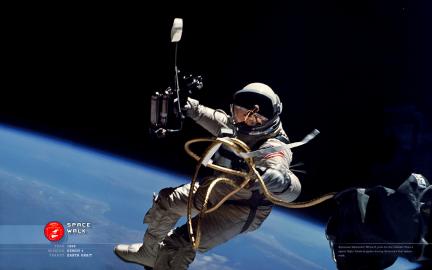 Ed White is the first American space walker, which took place on Mercury 7. Sadly, he later died on the ground in the tragic Apollo 1 flash fire which took place during a test run. The accident took the lives of 3 astronauts before Apollo even got off the ground.
Ed White is the first American space walker, which took place on Mercury 7. Sadly, he later died on the ground in the tragic Apollo 1 flash fire which took place during a test run. The accident took the lives of 3 astronauts before Apollo even got off the ground.
Note: I erroneously labeled this wallpaper as Mercury 7 and not Gemini 4. Image has been corrected.
Image Note: Some of the Earth image at the far left has been extended in Photoshop to fill out the space. The original image was square.
Wallpaper: Phoebe Portrait
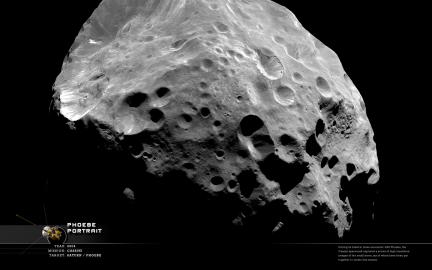 A few posts back I uploaded a closer detail of this same image. This is the best “portrait” image of Phoebe available taken by Cassini on its way into the Saturn system and orbit insertion. Being so far out from the rest of the most dle scientific targets (4x as far as Iapetus), this was the only up-close visit planned to the tiny moon who’s size is about 220km average width.
A few posts back I uploaded a closer detail of this same image. This is the best “portrait” image of Phoebe available taken by Cassini on its way into the Saturn system and orbit insertion. Being so far out from the rest of the most dle scientific targets (4x as far as Iapetus), this was the only up-close visit planned to the tiny moon who’s size is about 220km average width.
Wallpaper: Phoebe
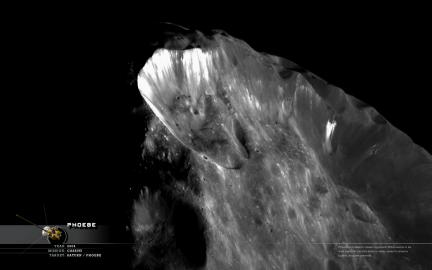 There appears to be a layer of dark material covering the small moon Phoebe as revealed by the collapse of materials in the northern region of the small moon. Phoebe orbits Saturn outside the orbit of Iapetus and has been considered a possible candidate for the dark material also found covering one side of that unusual moon. What may have caused this transfer of materials is still a mystery… or that Phoebe had anything to do with that feature on Iapetus is still very much in question.
There appears to be a layer of dark material covering the small moon Phoebe as revealed by the collapse of materials in the northern region of the small moon. Phoebe orbits Saturn outside the orbit of Iapetus and has been considered a possible candidate for the dark material also found covering one side of that unusual moon. What may have caused this transfer of materials is still a mystery… or that Phoebe had anything to do with that feature on Iapetus is still very much in question.
Some propose that Phoebe is actually a captured comet from the Kuiper belt (a region of small bodies orbiting the sun beyond Neptune of which Pluto is considered a member). If this is true, the images taken by cassini would be the only images of such bodies to be anything other than a single point of light.
Wallpaper: Southern Saturn
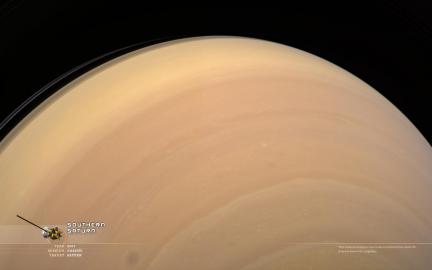 According to the Cassini website, this image was taken at about 58 degrees below the ring-plane in the southern hemisphere. The southern lower half of Saturn tends to appear yellow-peach while (at current) the northern half of Saturn leans to a white-grey-blue, with varying effects from the shadows of the rings cast upon the cloud tops (just visible on the middle-left). It is unusual to view such a large area of Saturn’s globe without the intrusion of rings or ring-shadows and it reminds us how gorgeous Saturn would be even without its stunning rings.
According to the Cassini website, this image was taken at about 58 degrees below the ring-plane in the southern hemisphere. The southern lower half of Saturn tends to appear yellow-peach while (at current) the northern half of Saturn leans to a white-grey-blue, with varying effects from the shadows of the rings cast upon the cloud tops (just visible on the middle-left). It is unusual to view such a large area of Saturn’s globe without the intrusion of rings or ring-shadows and it reminds us how gorgeous Saturn would be even without its stunning rings.
Wallpaper: Ganymede Up Close
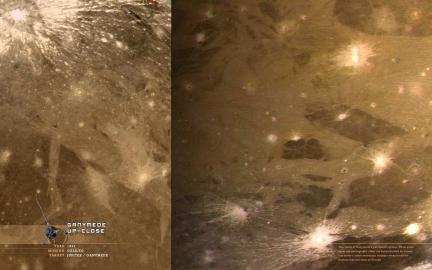 Two views of Ganymede’s patchwork surface taken by Galileo around 1997. While some areas appear geologically older (as demonstrated by the record of impact cratering) some seemingly younger areas recall the fracturous features seen at Europa. Many theorize, just as they do at Europa, that there may be a global ocean of water beneath the surface at Ganymede. However, it is also assumed (if if this does exist) that this ocean would be more shallow and under a much thicker crust of rock hard ice than that of Europa.
Two views of Ganymede’s patchwork surface taken by Galileo around 1997. While some areas appear geologically older (as demonstrated by the record of impact cratering) some seemingly younger areas recall the fracturous features seen at Europa. Many theorize, just as they do at Europa, that there may be a global ocean of water beneath the surface at Ganymede. However, it is also assumed (if if this does exist) that this ocean would be more shallow and under a much thicker crust of rock hard ice than that of Europa.

